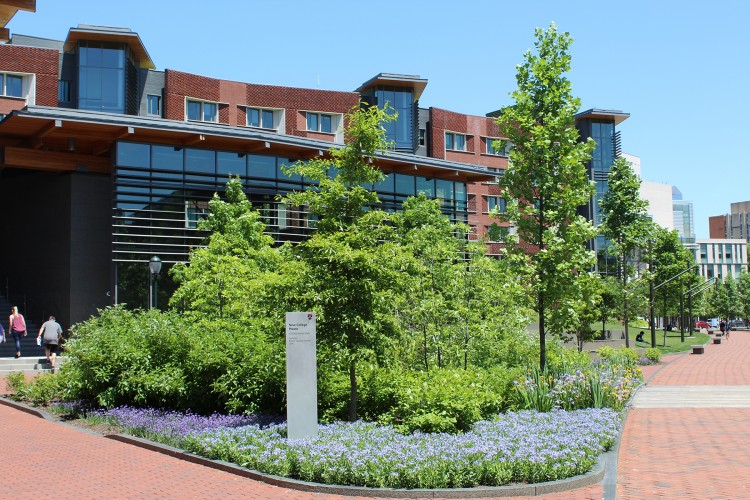Penn’s Green Landscapes: Beyond Aesthetics
While the parks, gardens and green spaces found across Penn’s campus certainly add to the aesthetic, there’s much more to them than visual appeal. Meeting the global and local sustainability goals set out by the Climate Action Plan 2.0 (Almanac October 28, 2014), the Penn Connects 2.0 (Almanac July 17, 2012), and the Penn Compact 2020, the campus landscaping efforts have been focused on being ecologically sound. Here are a few examples of landscaped areas across the campus that extend Ben’s edict of “both useful and ornamental” beyond the classroom and into the green spaces.
James G. Kaskey Memorial Park (BioPond)
Penn’s oldest green space that opened as a research garden in 1897, this oasis located near the Lynch Labs and the Levin Building. It is a cool, woodland oasis where over 500 trees thrive in the middle of the bustling urban campus. A waterfall and weeping water walls serve as a source for birds to drink from and also aerate water to keep it clean.
Shakespeare Garden
Located in front of the Duhring Wing of the Fisher Fine Arts Building, this tranquil spot that celebrates plants mentioned in Shakespeare’s writings has transitioned from featuring mostly annual plants, which require more maintenance, to more perennials and native plants which are lower maintenance.
Class of 1968 Legacy Garden
This space next to the Jaffe History of Art Building and Van Pelt-Dietrich Library transformed unused lawn area into a native perennial garden and cherry tree collection.
New College House
The landscaping in front of this student residence on Chestnut Street, between 33rd and 34th streets features native plants and pervious paving for storm water drainage.

Class of 1957 Geology Garden
Just west of Hayden Hall, this green space contains 10 boulders that represent the area’s geologic periods spanning 500 million years, from the Paleozoic through the Pleistocene eras. Each stone represents important transitions in the span of geologic time, while the plants growing here symbolize the evolutionary emergence of plant species.
Shoemaker Green
Shoemaker Green, between Franklin Field and the Palestra, is a 2.75 acre space that connects the main campus to Penn Park. Its rain garden contains highly absorptive engineered planting soils where floodplain species like bald cypress and sweetbay magnolia flourish. Stormwater filters through a system of trench drains and inlets before it enters the rain garden, where it is further filtered through a series of stone and vegetative swales. This area is also used as living laboratory, where faculty and students are active in monitoring the process of plant growth, soil health and water quality.
Pollinator Garden and Food Forest
With paw paws, quinces, figs, hardy kiwis, and persimmons, as well as pollinator plants, this garden near 38th and Spruce streets behind the Rosenthal Building brings bees, butterflies, and wildlife to an urban corner of campus, demonstrating the power of plants to create pockets of habitat even in developed sections of the city.
Penn Park
A stunning reclamation and re-imagination of a former industrial site, this park, which opened in 2011, increased green space on campus by nearly 20 percent and created a vibrant connection between Center City and West Philadelphia. Underground cisterns, bioswales and meadows capture rainwater and mitigate storm water overflow into the Schuylkill River. Over 500 mainly native canopy trees were carefully chosen for this 24-acre recreational space at the east end of campus.







